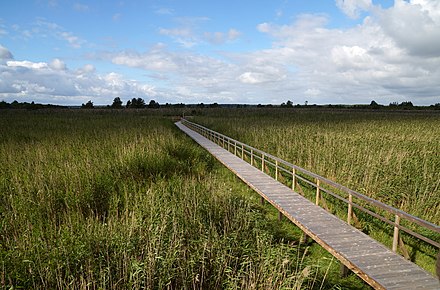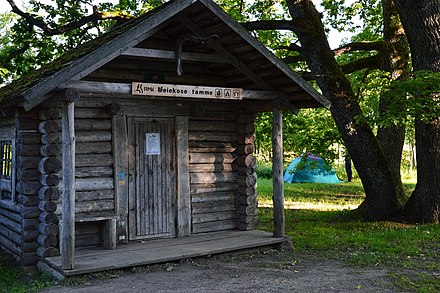Hiking in Estonia
Hiking in Estonia
Hiking is a great way to explore the forests, bogs, islands and the rural side of Estonia.
Understand
 Estonia is a good hiking destination for many reasons. Like in the rest of the Baltics, the Nordic countries, Scotland, and some Central European countries, everyone has the right to access. This means that in general no permits are needed and no fees are charged for exploring the nature and some other outdoor activites. In Estonia, this is a bit more strict than in the Nordic countries, for instance when it comes to staying overnight.
Estonia is a good hiking destination for many reasons. Like in the rest of the Baltics, the Nordic countries, Scotland, and some Central European countries, everyone has the right to access. This means that in general no permits are needed and no fees are charged for exploring the nature and some other outdoor activites. In Estonia, this is a bit more strict than in the Nordic countries, for instance when it comes to staying overnight.
The terrain is flat, and while there is plenty of nature to enjoy (due to low population density), except for small islands in the sea you will never be more than a day's walk away from civilization including shops, services, public transport and help. In addition Estonia is affordable compared to the Nordic countries (food, fares, lodging).
Estonia has a humid continental climate, with daytime temperatures during summer around +20°C, and frequently above. At these latitudes, there is daylight during most hours of the day during the summer. But days are correspondingly short during the winter, and at that time you should also expect temperatures well below freezing, and snow.
Destinations
More
There are more protected areas than the ones listed here. If you're looking at a map, the Estonian words for these areas are:
- Rahvuspark - national park
- Maastikukaitseala (MKA)/looduspark - nature park
- Looduskaitseala (LKA) - nature reserve
The State Forest Management Centre (RMK) is responsible for the country's national parks, reserves and official trails.
National parks
- Karula National Park 📍 - in the far south
- Lahemaa National Park 📍 - at the northern coast
- Matsalu National Park 📍 - south of Haapsalu
- Soomaa National Park 📍 - east of Pärnu
- Vilsandi National Park 📍 - in the west of Saaremaa
Nature reserves
- Alam-Pedja Nature Reserve 📍, north of Lake Võrtsjärv
- Endla Nature Reserve 📍, in the middle of the country
- Haanja Nature Park 📍, in southeastern Estonia, and including Estonia's highest hill, Suur Munamägi
- Naissaare Nature Park 📍, an island outside Tallinn
- Nigula Nature Reserve 📍, in southwestern Estonia
- Osmussaare Landscape Reserve 📍, an island outside Paldiski
- Otepää Nature Park 📍, in the south of the country, known for winter sports
- Peipsiveere Nature Reserve 📍, on the western shore of Lake Peipus
- Piusa Caves Nature Reserve 📍, in southeastern Estonia
- Silma Nature Reserve 📍, east of Haapsalu
- Viidumäe Nature Reserve 📍, in the west of Saaremaa
- Vormsi Landscape Reserve 📍, an island outside Haapsalu
Trails
 Protected areas usually have hiking trails of a few kilometers in length, so you can explore them for a day or a few hours. For long-distance hikes, there are three national long distance trails. These three routes meet in the town of Aegviidu 📍, about 50 km southeast of Tallinn on the Tallinn-Narva railway.
Protected areas usually have hiking trails of a few kilometers in length, so you can explore them for a day or a few hours. For long-distance hikes, there are three national long distance trails. These three routes meet in the town of Aegviidu 📍, about 50 km southeast of Tallinn on the Tallinn-Narva railway.
- The Oandu-Ikla route is 375 km long and goes from Oandu 📍 on the northern coast to Ikla 📍 in southwestern Estonia at the Latvian border.
- The Penijõe-Kauksi route is 614 km long and goes from Penijõe 📍 at the west coast almost all the way to Narva, then south to Kauksi 📍 on the shore of Lake Peipus.
- The Peraküla-Ähijärve route is 820 km long and goes from Peraküla 📍 in the northwestern corner of Estonia to the southeast of the country and follows the Latvian border back west to Ähijärve 📍.
- In addition the northeastern portion of the E9 European Coast Path goes all the way along the Estonian coastline from Ikla 📍 at the Latvian border to Narva-Jõesuu 📍 at the border with Russia.
See
See also: Eurasian wildlife
Animal and plant life is similar to nearby Finland and Sweden. Coastal Estonia is known for its pine forests and sand beaches, very reminiscent of Hanko peninsula in far southern Finland. Moreover, Estonia is known for its bogs.
Big wild animals of notice are moose, deer, wild boars and more rarely wolves, lynx, and brown bears.
Get in and around
There's a chance you will enter Estonia through Tallinn, by boat or plane. From there you can get by bus or train almost anywhere in the country. If you want to start your natural journey right away, there are some campgrounds within 20-30 km of Tallinn.
Major border crossings such as Ikla/Ainazi between Pärnu and Riga often have trailheads or camping grounds nearby, so you can hit the trail right when you've entered the country. Latvia is, like Estonia member of the Schengen area and you can as such cross between the countries as you like (the freedom to roam also applies in Latvia), but the Russian border is a completely different story.
Protected areas, camping grounds and trailheads are often also accessible by car.
You can also get in and around by boat, see Boating on the Baltic Sea#Boating in Estonia for details.
Eat and drink
The right to access also includes picking wild berries and mushrooms as well as fishing.
Often you'll not be far from civilization, so you don't need to carry weeks worth of supplies.
Tap water is mostly drinkable. Water from natural sources is reportedly drinkable after boiling.
Sleep
 In protected areas and along trails, you're only allowed to set up a tent at designated places (or stay at huts) but it is free of charge. RMK also maintains campsites and huts elsewhere, and they are free too. Elsewhere you need to ask permission of the landowner (in the case of public lands, the forest office) beforehand.
In protected areas and along trails, you're only allowed to set up a tent at designated places (or stay at huts) but it is free of charge. RMK also maintains campsites and huts elsewhere, and they are free too. Elsewhere you need to ask permission of the landowner (in the case of public lands, the forest office) beforehand.
Paid accommodation won't probably break the bank; tent sites are often less than €10/night and rural accommodation is often €50/night or less.
Stay healthy and safe
Estonia is in general a safe country. Hiking on roads, you must watch out for traffic.
Like in most of Europe, the nature isn't particularly dangerous. There are some dangerous animals such as bears, but you're not likely to encounter them as they mostly avoid people.
The European viper (vipera berus) is the only venomous snake. Its bite is potentially fatal, so if you get bitten, you should see a doctor. Ticks are probably the animals you need to be most afraid of; these tiny arachnids bite and can carry tick-borne meningoencephalitis (TBE) and lyme disease (borreliosis). There's a vaccine available against the former, while the latter can be treated with antibiotics. Both are nasty; check your or your buddy's body in the evening, to find any ticks before they bite or before they have been attached for extended times. Mosquitoes don't carry any diseases but they do sting and in great number and due to their aggressiveness they can be annoying.
See also
- Hiking in the Nordic countries — much of the advice applies in Estonia too